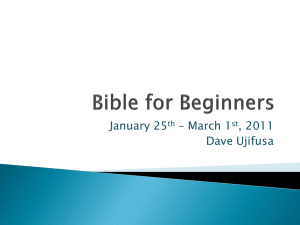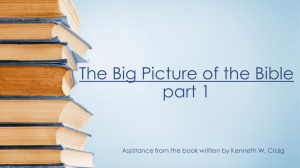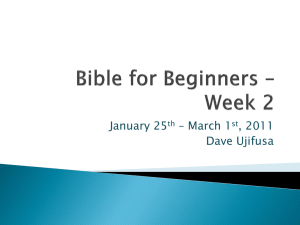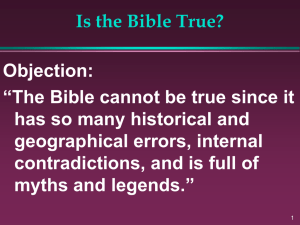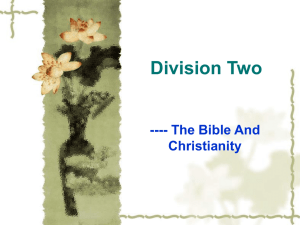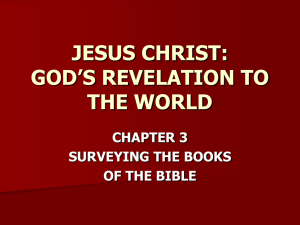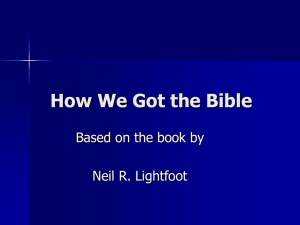Byblos
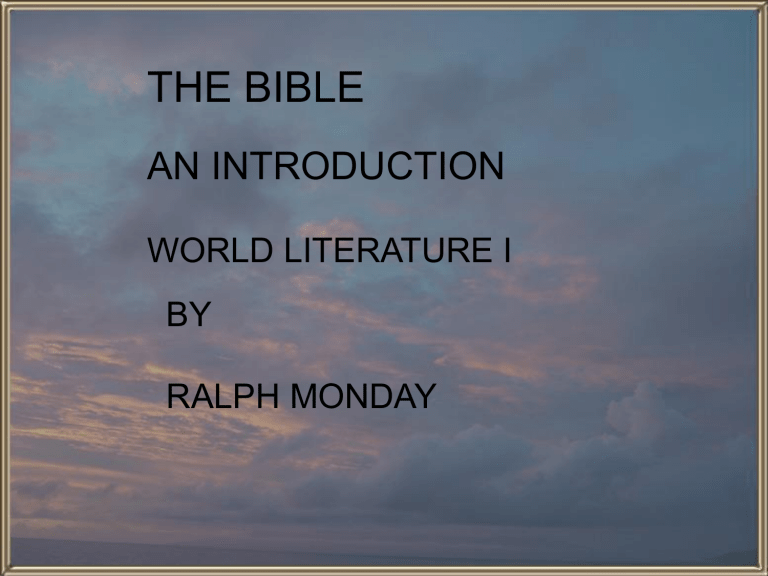
THE BIBLE
AN INTRODUCTION
WORLD LITERATURE I
BY
RALPH MONDAY
The Bible
That most of
Us are
Familiar with:
The King
James
Version,
Translated in
1611.
QUESTIONS READERS ASK ABOUT
THE BIBLE
• AGE
• AUTHORSHIP
• ORIGINAL
LANGUAGES
• PERTINENT
QUESTIONS
• SINCE
• INDIVIDUALS ARE
ALWAYS CURIOUS
• ABOUT THE
ORIGIN OF THEIR
FAITH.
1. What is the Bible?
• Known as the Good
Book, as though it were a single volume, the Bible is a collection or library
• Of many small books written over a period of more than a thousand years.
• The Hebrew Bible, known to Christians as the Old
Testament, is primarily a record of
• The Hebrew god’s dealings with his chosen people,
Israel.
Moses with
The
Commandments.
The word of
God come
Down from
The sky.
Revealed
Religion.
• The Old Testament is made up of 24 books, divided into
39 in the Christian
Bible,
• Of narrative, poetry, and prophecy.
• It is a book that many millions of people have based their life upon.
• Christians add to the original Hebrew the
New Testament, consisting of
• The Gospel--four narratives of Jesus’ life, a theological account of the early
Church (Acts), 21 letters, and an apocalypse
(revelation of future history).
2. WHAT DOES THE WORD BIBLE
MEAN?
Bible means “little books.” The word is
• City of Byblos, derived from the where the papyrus
Greek term biblion, plant was cut and dried in strips
The diminutive form of
• For use as writing
Byblos , which means “papyrus” or
“book.” paper.
• Thus, the
This concept manuscript material originated in the produced was ancient Phoenician named after the place of its manufacture.
Ruins of the
Ancient city of
Byblos.
B
YBLOS (JBEIL)
Byblos, one of the oldest continuously inhabited cities in the world, its history reaches into antiquity. It is one of the richest archeological sites in the Middle
East. It was the religious and commercial capital of the Phoenician coast and it was here where the first linear alphabet was invented.
Byblos has given its name to the Bible.
The city of Byblos is one of the oldest cities in the world, having been inhabited continuously since Neolithic times more than 7000 years ago. It is located in today's Lebanon, about 35 km north of Beirut. In ancient times it was an important sea port from which the famous cedar trees of Lebanon were exported to Egypt in exchange for papyrus, ivory, ebony and gold. Trade goods from as early as Egypt's 2nd dynasty have been found there. Byblos is also noteworthy as the place where the linear alphabet was invented. This became the basis for the modern alphabet that we use today.
The local goddess of Byblos was Astarte, whose spheres of influence included war, protection, love and fertility. She was known as the Baalat Gebal, the "Lady of Byblos."
The Temple of Baalat Gebal, the "Lady of Byblos"
This is Inanna or Ishtar —the same archetype.
3. Who Wrote the Bible?
• No one knows.
• The Old Testament authors were not concerned with personal recognition – they were interested in
• Their sense of
Israel’s god and his purpose for the world.
• Thus, Old Testament authorship is typically anonymous,
• Although later traditions assigned important books to eminent figures of the past.
In the last several centuries B.C.E., Moses was regarded
As the author of the first five books of the Bible —
The Pentateuch.
However, most modern scholars believe that these books
Assumed their present form long after Moses’ time.
The majority of the narrative works —Joshua, Judges,
Samuel, Kings, and Chronicles —are the work of nameless
Priests, scribes, and archivists.
Scholars believe that the great prophets —Amos, Isaiah,
Micah, and others —delivered their messages orally and
That their words were collected and written down by later
Disciples whose names are unknown.
4. When Was The Bible Written?
• The Bible is dated by most scholars from the creation to
• Israel’s conquest of
Palestine —
• About the tenth century B.C.E.
• This document forms the oldest
• Narrative strand in the Pentateuch, and is characterized by its consistent use of
• The personal name
Yahweh for the
Hebrew god, and is
• Usually called J, for
Jahveh, the German form of the divine name .
The Old Testament took approximately 1000 years to
Assume its present form. The New Testament took about
100 years. 1100 years comprise the Bible’s creation.
5. Is the Bible the World’s Oldest Book?
• No. At one time scholars believed that the Bible was the only significant literary production of the ancient near east.
• In the 19 th century, in the library of the
Assyrian Emperor
• Ashurbanipal IV
(668-627 B.C.E.), in the ruins of his palace at Nineveh, capital of the
Assyrian empire,
• Hundreds of clay tablets were discovered written in cuneiform.
The most important find were eleven tablets
Recounting the legendary adventures of
Gilgamesh, King of Uruk.
A startlingly find was the story of Utnapishtim
Who survived a great flood by building an ark
According to the directions of Ea, the god of
Wisdom.
The story is remarkably similar to the flood story
In Genesis, and the story is believed to go back
To a single source, although the Gilgamesh
Version is much older.
Noah
Having
A
Problem
With a
Woodpecker.
6. In What Languages Was the Bible
Originally Written?
Most of the Old Testament was written in classical
Hebrew, the Semitic tongue spoken by the
Israelites.
Later, certain books were composed in Aramaic,
An Aramean (Syrian) dialect closely related to
Hebrew.
This is the language probably spoken by Jesus.
All of the New Testament is in Koine, the international
Language of the first-century workaday world, a
Blend of classical Greek with the commercial
Vernacular of Near Eastern peoples conquered by
Alexander the Great.
7. When Was The Bible First Translated?
• The first translation of the Hebrew Bible was begun in
Alexandria, Egypt.
• This occurred in the mid-third century before Christ because the younger generation
• Of Jews no longer understood classical
Hebrew.
• This is called the
Septuagint after the
70 elders who supposedly produced it.
• It took more than two centuries to produce the translation.
The Pentateuch (Genesis through Deuteronomy)
Was translated first, followed by the prophetic
Books and the Writings (poetic and wisdom
Literature), and eventually by works that became
Known as the Apocrypha.
The Septuagint was the Bible adopted by the early
Greek-speaking Christians.
The next translation was St. Jerome’s production of
The Latin Vulgate. This was commissioned by the
Bishop of Rome to render the Scriptures into the
Common tongue for the Latin-speaking Western
Church. Jerome, between 385 and 405 C.E.
Produced the official Bible of Roman Catholicism.
8. How Did Our Modern English
Translations Come About?
Two historical events ensured that the Bible would
Have a larger English reading public.
The first was Johann Gutenberg’s invention of
Moveable type in 1455.
The second was the Protestant Reformation,
Started in 1517 by Martin Luther.
Luther completed a German translation in 1522-34 —
The first version in a modern European language
Based not on the official Latin Vulgate Bible but
On the original Hebrew and Greek.
William Tyndale first translated the Bible into English
(the New Testament) in 1525. He had to flee to
Germany to do this, because he was under threat
Of persecution.
He never entirely completed his translation of the
Old Testament, because in 1535-36 he was betrayed,
Tried for heresy, and burned at the stake.
The first freely distributed English Bible —the Coverdale
Bible —(1535) relied heavily on Tyndale’s work.
By far, the most popular version of all time is the King
James English version, produced by scholars in 1611.
9. What Is Meant By Canon?
The term canon refers to the standard or
Measurement by which books were included or
Excluded from the final list of authoritative
Scripture.
In Greek, canon means a straight stick by which
Something is ruled or measured.
The Hebrew word qaneh also referred to measurement or the norm by which something
Was judged.
10. Which Parts Of The Bible Were First
Accepted As Canonical?
At about 400 B.C.E. the Jews decided that the
First five books of the Bible —Genesis, Exodus,
Leviticus, Numbers, Deuteronomy —were
Authoritative and binding.
These five scrolls are called the Pentateuch, and
Make up the Torah, meaning “law” or “instruction.”
These are the words that Yahweh gave to Israel
Through Moses, and remains, for Jews, the core nucleus to which all other parts of scripture accrue.

